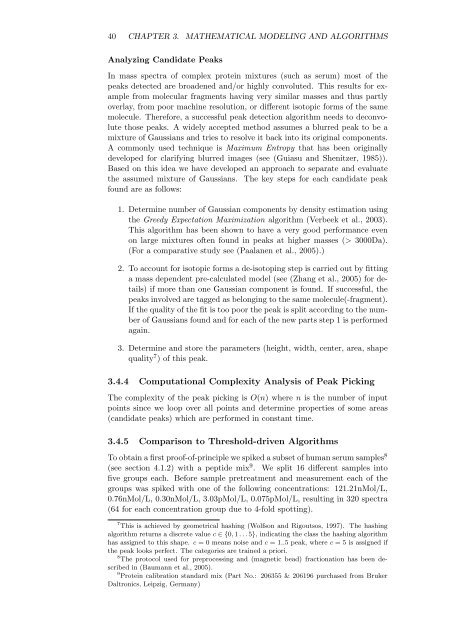New Statistical Algorithms for the Analysis of Mass - FU Berlin, FB MI ...
New Statistical Algorithms for the Analysis of Mass - FU Berlin, FB MI ...
New Statistical Algorithms for the Analysis of Mass - FU Berlin, FB MI ...
Create successful ePaper yourself
Turn your PDF publications into a flip-book with our unique Google optimized e-Paper software.
40 CHAPTER 3. MATHEMATICAL MODELING AND ALGORITHMS<br />
Analyzing Candidate Peaks<br />
In mass spectra <strong>of</strong> complex protein mixtures (such as serum) most <strong>of</strong> <strong>the</strong><br />
peaks detected are broadened and/or highly convoluted. This results <strong>for</strong> example<br />
from molecular fragments having very similar masses and thus partly<br />
overlay, from poor machine resolution, or different isotopic <strong>for</strong>ms <strong>of</strong> <strong>the</strong> same<br />
molecule. There<strong>for</strong>e, a successful peak detection algorithm needs to deconvolute<br />
those peaks. A widely accepted method assumes a blurred peak to be a<br />
mixture <strong>of</strong> Gaussians and tries to resolve it back into its original components.<br />
A commonly used technique is Maximum Entropy that has been originally<br />
developed <strong>for</strong> clarifying blurred images (see (Guiasu and Shenitzer, 1985)).<br />
Based on this idea we have developed an approach to separate and evaluate<br />
<strong>the</strong> assumed mixture <strong>of</strong> Gaussians. The key steps <strong>for</strong> each candidate peak<br />
found are as follows:<br />
1. Determine number <strong>of</strong> Gaussian components by density estimation using<br />
<strong>the</strong> Greedy Expectation Maximization algorithm (Verbeek et al., 2003).<br />
This algorithm has been shown to have a very good per<strong>for</strong>mance even<br />
on large mixtures <strong>of</strong>ten found in peaks at higher masses (> 3000Da).<br />
(For a comparative study see (Paalanen et al., 2005).)<br />
2. To account <strong>for</strong> isotopic <strong>for</strong>ms a de-isotoping step is carried out by fitting<br />
a mass dependent pre-calculated model (see (Zhang et al., 2005) <strong>for</strong> details)<br />
if more than one Gaussian component is found. If successful, <strong>the</strong><br />
peaks involved are tagged as belonging to <strong>the</strong> same molecule(-fragment).<br />
If <strong>the</strong> quality <strong>of</strong> <strong>the</strong> fit is too poor <strong>the</strong> peak is split according to <strong>the</strong> number<br />
<strong>of</strong> Gaussians found and <strong>for</strong> each <strong>of</strong> <strong>the</strong> new parts step 1 is per<strong>for</strong>med<br />
again.<br />
3. Determine and store <strong>the</strong> parameters (height, width, center, area, shape<br />
quality 7 ) <strong>of</strong> this peak.<br />
3.4.4 Computational Complexity <strong>Analysis</strong> <strong>of</strong> Peak Picking<br />
The complexity <strong>of</strong> <strong>the</strong> peak picking is O(n) where n is <strong>the</strong> number <strong>of</strong> input<br />
points since we loop over all points and determine properties <strong>of</strong> some areas<br />
(candidate peaks) which are per<strong>for</strong>med in constant time.<br />
3.4.5 Comparison to Threshold-driven <strong>Algorithms</strong><br />
To obtain a first pro<strong>of</strong>-<strong>of</strong>-principle we spiked a subset <strong>of</strong> human serum samples 8<br />
(see section 4.1.2) with a peptide mix 9 . We split 16 different samples into<br />
five groups each. Be<strong>for</strong>e sample pretreatment and measurement each <strong>of</strong> <strong>the</strong><br />
groups was spiked with one <strong>of</strong> <strong>the</strong> following concentrations: 121.21nMol/L,<br />
0.76nMol/L, 0.30nMol/L, 3.03pMol/L, 0.075pMol/L, resulting in 320 spectra<br />
(64 <strong>for</strong> each concentration group due to 4-fold spotting).<br />
7<br />
This is achieved by geometrical hashing (Wolfson and Rigoutsos, 1997). The hashing<br />
algorithm returns a discrete value c ∈ {0, 1 . . . 5}, indicating <strong>the</strong> class <strong>the</strong> hashing algorithm<br />
has assigned to this shape. c = 0 means noise and c = 1..5 peak, where c = 5 is assigned if<br />
<strong>the</strong> peak looks perfect. The categories are trained a priori.<br />
8<br />
The protocol used <strong>for</strong> preprocessing and (magnetic bead) fractionation has been described<br />
in (Baumann et al., 2005).<br />
9<br />
Protein calibration standard mix (Part No.: 206355 & 206196 purchased from Bruker<br />
Daltronics, Leipzig, Germany)









